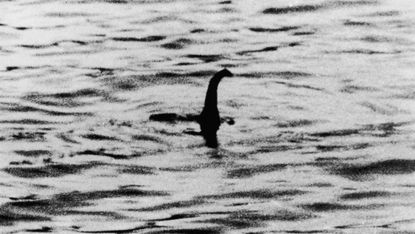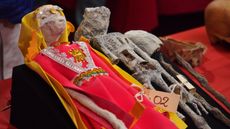New discovery makes Loch Ness Monster ‘plausible’
And other stories from the stranger side of life

The existence of the Loch Ness Monster is “plausible”, a British university has concluded. Scientists found fossils of small plesiosaurs – long-necked marine reptiles from the age of dinosaurs – in a 100-million-year-old river system in Morocco’s Sahara Desert. The finding suggests the reptiles may have lived in freshwater. Images and eyewitness accounts have suggested that the beast has a long neck and small head similar to a plesiosaur. However, said The Independent, sceptics have argued that plesiosaurs could not have lived in Loch Ness as they needed a saltwater environment.
Dogs ‘can understand intention’
Dogs may be able to understand our intentions, according to a new study. Researchers from the University of Veterinary Medicine in Vienna either fumbled and dropped dog treats or withheld them. They noted that the dogs appeared to recognise when they were being “clumsy” and when they were being “mean”, said The Times. “Our results… provide robust evidence that dogs distinguish between similar actions (leading to the same outcome) associated with different intentions,” said the team, which studied the responses of 96 dogs of various breeds and ages.
Subscribe to The Week
Escape your echo chamber. Get the facts behind the news, plus analysis from multiple perspectives.

Sign up for The Week's Free Newsletters
From our morning news briefing to a weekly Good News Newsletter, get the best of The Week delivered directly to your inbox.
From our morning news briefing to a weekly Good News Newsletter, get the best of The Week delivered directly to your inbox.
Hirst to burn his artworks
The artist Damien Hirst is to burn thousands of his paintings next month in a project focusing on art as currency. The Guardian said Hirst will destroy the artworks at his London gallery. Buyers were given the option of keeping NFTs or trading them in for the physical artwork. Those works which were not claimed in physical form will be burned on a daily basis from 9 September. Last year, Hirst said the project, titled The Currency, was an “interesting experiment”.
Sign up for Today's Best Articles in your inbox
A free daily email with the biggest news stories of the day – and the best features from TheWeek.com
Create an account with the same email registered to your subscription to unlock access.
-
 Who actually needs life insurance?
Who actually needs life insurance?The Explainer If you have kids or are worried about passing on debt, the added security may be worth it
By Becca Stanek, The Week US Published
-
 Sexual wellness trends to know, from products and therapies to retreats and hotels
Sexual wellness trends to know, from products and therapies to retreats and hotelsThe Week Recommends Talking about pleasure and sexual health is becoming less taboo
By Theara Coleman, The Week US Published
-
 Is the AI bubble deflating?
Is the AI bubble deflating?Today's Big Question Growing skepticism and high costs prompt reconsideration
By Joel Mathis, The Week US Published
-
 Zoos offer cockroach naming and hippo poo candles
Zoos offer cockroach naming and hippo poo candlesTall Tales And other stories from the stranger side of life
By Chas Newkey-Burden, The Week UK Published
-
 NHS tells Scots to walk like penguins
NHS tells Scots to walk like penguinsTall Tales Walk like penguins in the snow, says NHS
By Chas Newkey-Burden, The Week UK Published
-
 Experts discover why dogs wag their tails
Experts discover why dogs wag their tailsTall Tales And other stories from the stranger side of life
By Chas Newkey-Burden, The Week UK Published
-
 Investigation into 'oldest ever dog' award
Investigation into 'oldest ever dog' awardTall Tales And other stories from the stranger side of life
By Chas Newkey-Burden, The Week UK Published
-
 Peruvian 'aliens' aren't really aliens
Peruvian 'aliens' aren't really aliensTall Tales And other stories from stranger side of life
By Chas Newkey-Burden, The Week UK Published
-
 Woman accidentally puts nan in washing machine
Woman accidentally puts nan in washing machineTall Tales And other stories from the stranger side of life
By Chas Newkey-Burden, The Week UK Published
-
 'Dirty work' to retrieve cash eaten by a dog
'Dirty work' to retrieve cash eaten by a dogTall Tales And other stories from the stranger side of life
By Chas Newkey-Burden, The Week UK Published
-
 Penile fracture risk higher over Christmas
Penile fracture risk higher over ChristmasTall Tales And other stories from the stranger side of life
By Chas Newkey-Burden, The Week UK Published